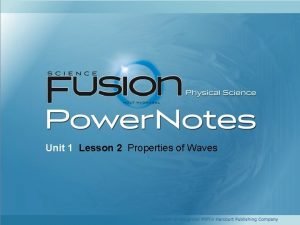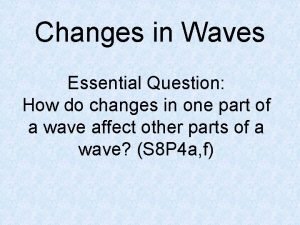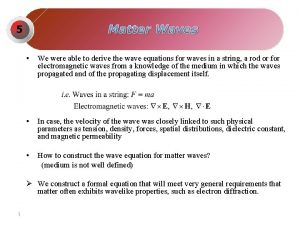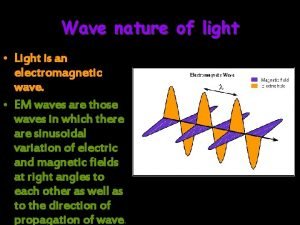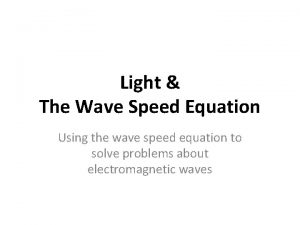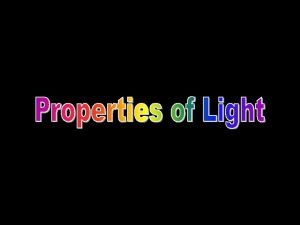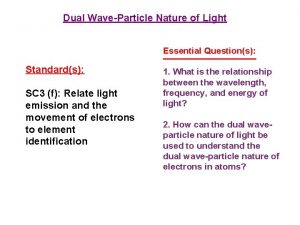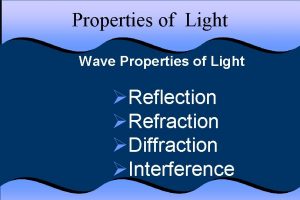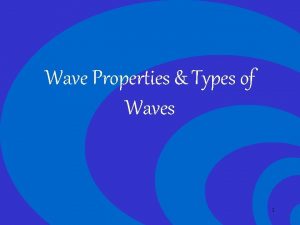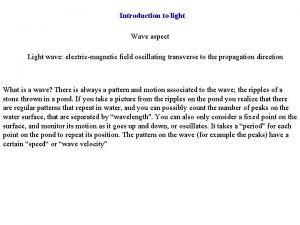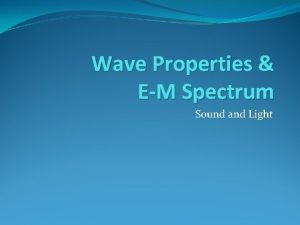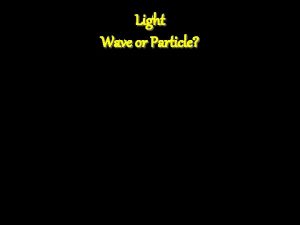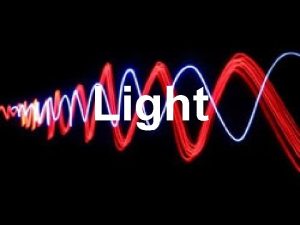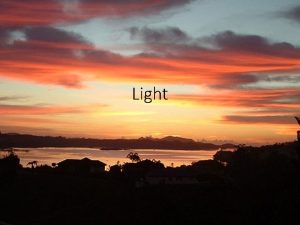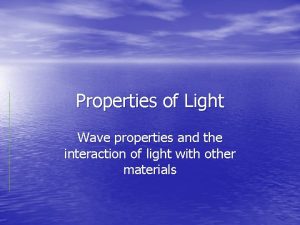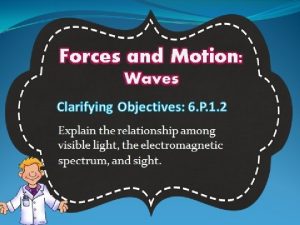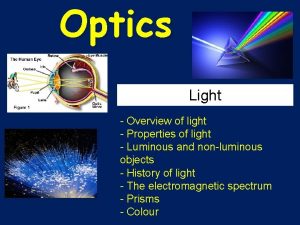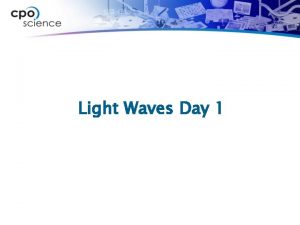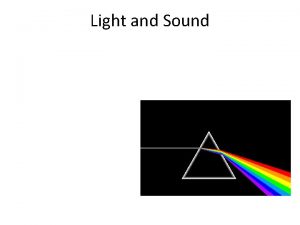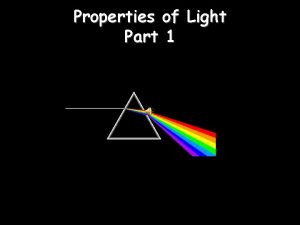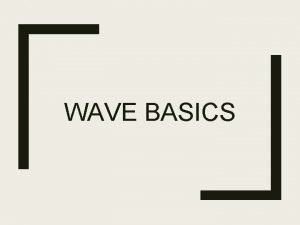Wave Properties of Light Light Wave Properties of


























- Slides: 26

Wave Properties of Light

Light Wave Properties of Light Ø Reflection Ø Refraction Ø Diffraction Ø Interference Ø Absorption Ø Scattering

1. Reflection When a wave strikes an object and bounces off NORMAL Incident ray Angle of incidence Reflected ray Angle of reflection SURFACE or boundary Animation

ØSPECULAR – smooth surface ØDIFFUSE- rough surfaces

2. Refraction Bending when passing from one medium to another causes a change in speed. • slower (more dense) light bends toward the normal • faster (less dense) light bends away from the normal Animation SLOWER FASTER

Refraction ØIndex of Refraction:

HIGH LOW HIGH

Refraction Link

Refraction ØThe “Broken Pencil” w refraction Explanation

3. Diffraction & Interference constructive brighter light destructive dimmer light Ø Occurs in thin films Ø Wave reflects off backside and interferes with incoming wave. Reflection off top and bottom

4. Scattering w interaction between light and matter that causes light to change direction. • Light scatters in all directions • EX. Sky is blue

No atmosphere

Like on the moon where there is not an atmosphere…

Shorter wavelengths, green blue and violet scatter the most – but not much violet so we see blue. When the air is really clean we see a deeper blue. Add the atmosphere


Clouds are white because water molecules are much larger and scatter color equally so we see white light.

Without particles (clean air)

Ø Now we'll add some particles. When you look at the mountain you see brown and green light plus some white light that is coming from sunlight being scattered by the particles (the white light is colored yellow in the figure at left). Some white specks of light have been superimposed on the view of the mountain at right.


Ø Scattering of sunlight effects visibility – cleaner air = better visibility but more distance between you and the object = more scattering.

Eventually everything looks blue…


At Point 1 in the figure we assume the incoming sunlight is white because it is a mixture of equal amounts of all the colors. After this sunlight travels a short way through the atmosphere some of the shorter wavelengths get scattered and removed from the incoming beam of light. The scattered light, Point 3, is what you see when you look at the sky. Only a small fraction of the light in the original beam is scattered, so it's not as intense as the original beam and safe to look at. It's also colored blue. The unscattered light, at Point 2, is the original mix of colors with a little bit of some of the shorter wavelengths removed. This can change the color slightly from white to a warmer shade of white (colored yellow in the figure above.

When the rays of sunlight take a longer path through the atmosphere much more scattering can occur. With enough scattering, almost all of the shorter wavelengths can be removed from the original beam of sunlight. This turns the unscattered light orange or red.

Ø Because the sunlight that strikes the clouds at sunset (or sunrise) is orange or red, the clouds themselves will appear orange or red.

5. Absorption is converted to heat. incoming light energy
 Light light light chapter 23
Light light light chapter 23 Into the light chapter 22
Into the light chapter 22 Light light light chapter 22
Light light light chapter 22 Longitudinal vs transverse wave
Longitudinal vs transverse wave What is a semiconductor used for
What is a semiconductor used for Difference between full wave and half wave rectifier
Difference between full wave and half wave rectifier Example of longitudinal wave
Example of longitudinal wave Half full wave rectifier
Half full wave rectifier Full wave bridge rectifier diagram
Full wave bridge rectifier diagram P and s wave arrival time chart
P and s wave arrival time chart Rectified sine wave fourier series
Rectified sine wave fourier series Wave wave repeating
Wave wave repeating The wave chapter 10
The wave chapter 10 Quarter wave symmetry
Quarter wave symmetry Mechanical waves and electromagnetic waves
Mechanical waves and electromagnetic waves Mechanical wave
Mechanical wave Velocity frequency wavelength triangle
Velocity frequency wavelength triangle Lesson outline lesson 2 wave properties answer key
Lesson outline lesson 2 wave properties answer key Properties of sound
Properties of sound Changes in wave properties sorting activity answer key
Changes in wave properties sorting activity answer key Properties of mechanical waves
Properties of mechanical waves What are matter waves
What are matter waves Wave nature of light
Wave nature of light Wave speed equation practice problems
Wave speed equation practice problems Is light an electromagnetic wave
Is light an electromagnetic wave What is meant by the dual wave particle nature of light
What is meant by the dual wave particle nature of light Light wave vocabulary
Light wave vocabulary

















